- Table of Content
- 1.SC25 update
- 2.Code Red!
- 3.Topical Issue
- 4.Review of Spac...
- 5.International ...
- 6.PROBA2 Observa...
- 7.Noticeable Sol...
- 8.Geomagnetic Ob...
- 9.Review of Iono...
- 10.The SIDC Space...
- 11.Upcoming Activ...
2. Code Red!
3. Topical Issue
4. Review of Space Weather
5. International Sunspot Number by SILSO
6. PROBA2 Observations
7. Noticeable Solar Events
8. Geomagnetic Observations in Belgium
9. Review of Ionospheric Activity
10. The SIDC Space Weather Briefing
11. Upcoming Activities
SC25 update
The STCE's SC25 Tracking page (https://www.stce.be/content/sc25-tracking ) has been updated to reflect the latest evolution of some critical space weather parameters for the ongoing solar cycle 25 (SC25). It covers various aspects of space weather, from sunspot numbers over geomagnetic indices all the way to cosmic rays. The multiple graphs allow for a comparison with previous solar cycles at similar stages in their evolution.
Active region NOAA 13664 gave a face to the ongoing SC25. It was the largest sunspot group in more than a decade, produced the strongest solar flare so far this solar cycle, was the most flare productive region in more than 3 decades, and the source of the coronal mass ejection that eventually would lead to the strongest geomagnetic storm in two decades. The image below shows flaring activity on the Sun. This extreme ultraviolet image was made by GOES/SUVI 094. On 8 and 9 May, the Sun produced no less than 28 M- and X-class flares, 20 of them courtesy of his majesty NOAA 13664. A clip is in the online version of this newsitem at https://www.stce.be/news/708/welcome.html
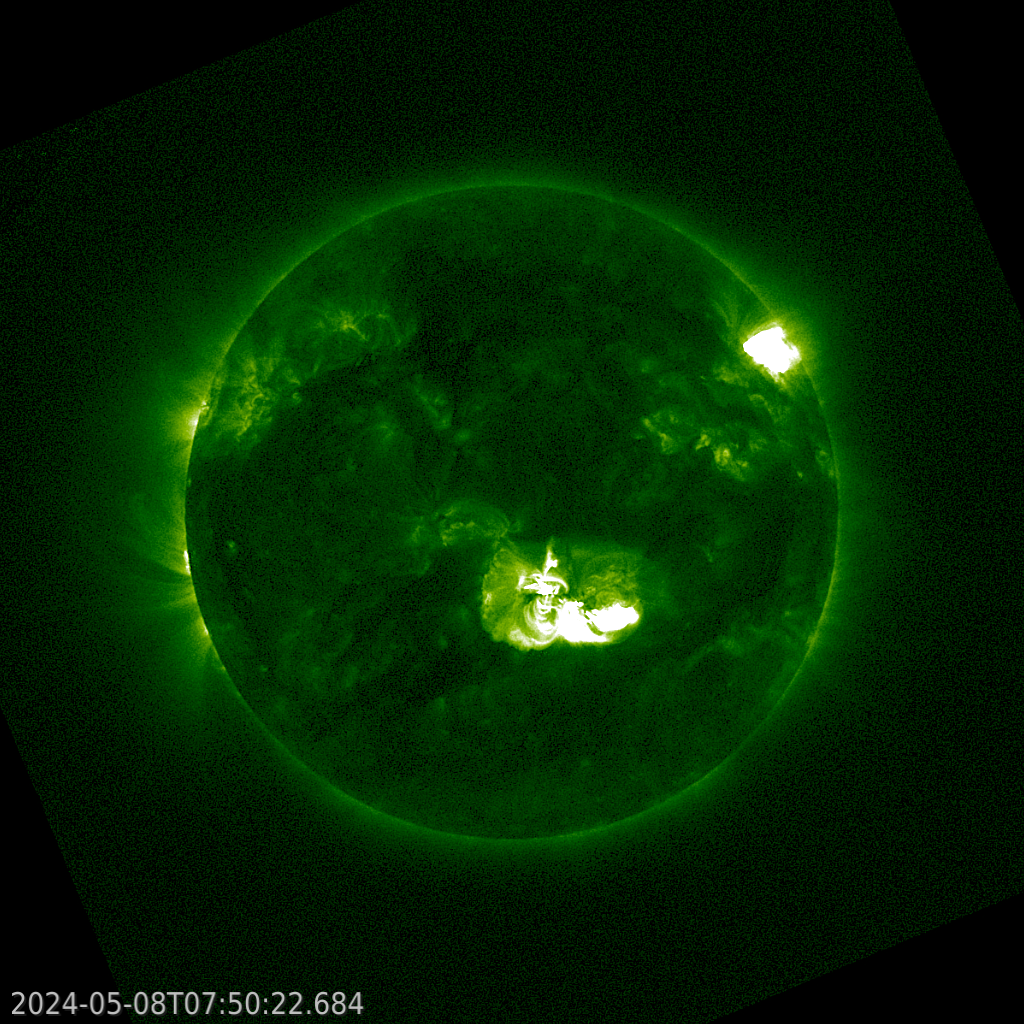
The rise of solar activity over the last 2 months may indicate that SC25 is moving to its second maximum, the first one having already occurred in June 2023. Typical solar activity parameters such as the smoothed sunspot number, the solar radio flux and the number of CMEs show a gradual rise again. This second maximum is still thought to occur later this year, with the SILSO predictions for SC25 maximum (12-month window ; https://www.sidc.be/SILSO/forecasts ) gradually converging to a maximum between 130 and 140 in the second half of 2024, thus remaining well above the initial prediction by the SC25 Panel (115).
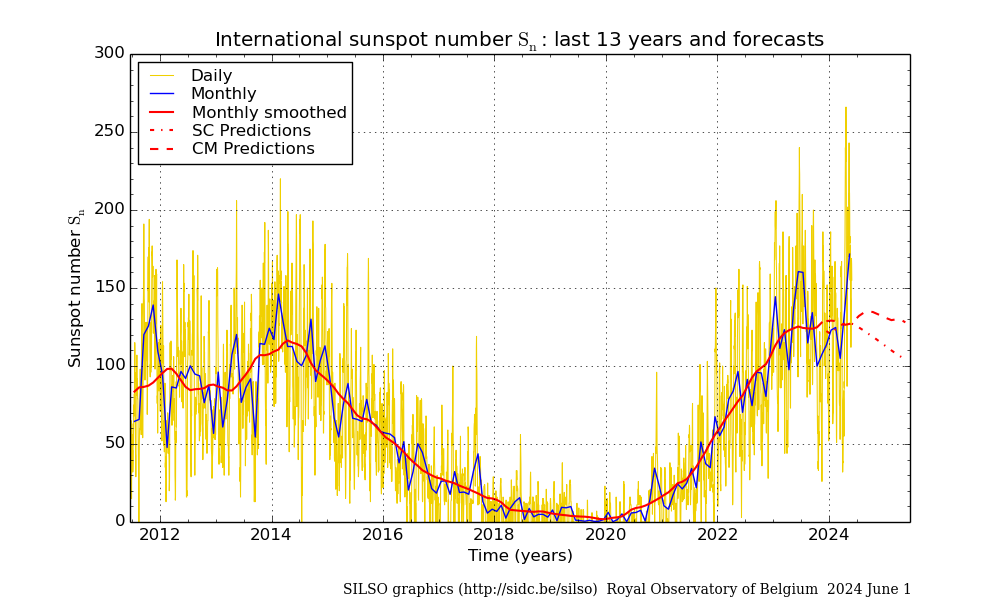
Code Red!
1815, the Tambora volcano erupted with such force that temperatures dropped around the world - it was the start of a year without summer and a global famine.
1859, a powerful solar storm crippled the global telegraph network. It was the only widespread technology at the time, but what if it happened again?
1908, a meteorite struck and destroyed an area in Siberia the size of the country of Luxembourg
1918, the Spanish flu claimed 50 million victims
These were global disasters, almost forgotten, but someday they will happen again. Are we ready for another code red?
In his newest book, science author and co-organizer of the Flemish Nerdland Festival Toon Verlinden takes the reader on a voyage of discovery through the wonderful world of solar eruptions, volcanoes, viruses and meteorites that may hit uncomfortably close to home.
For the chapters on solar storms, meteorites and vulcanic eruptions, the author collaborated closely with the space weather forecasters, solar and atmospheric scientists, meteor experts and instrument operators at the STCE.

Topical Issue
The Journal of Space Weather and Space Climate (JSWSC - https://www.swsc-journal.org/) opens the Topical Issue "Swarm 10-Year Anniversary", deadline 15 February 2025.
The topical issue (TI) is dedicated to new results from ESA's Swarm mission, in particular to investigations of the Magnetosphere-Ionosphere Coupling, Ionospheric and Thermospheric processes, and their implications for Space Weather, including potential impacts on critical infrastructure. This issue seeks to bring together cutting-edge studies that shed light on the quiet-time and dynamic ionosphere, including the study of Alfven waves, Equatorial Spread-F events, plasma bubbles, ULF plasma waves, Field-Aligned Currents etc.
Swarm is ESA's first constellation mission for Earth Observation. The mission consists of three identical satellites, A(lpha), B(ravo), and C(harlie), which were launched on 22 November 2013 into a low altitude (about 500 km) near-polar orbit. Swarm is dedicated to creating a highly detailed survey of Earth's geomagnetic field and its temporal evolution, complemented by electric field and neutral atmosphere observations in the topside ionosphere-thermosphere. After an initial nominal mission of four years, until November 2017, Swarm was granted two four-year extensions, with an option to further extend the mission, possibly towards covering two solar cycles. Swarm data presents an invaluable opportunity to validate, refine, and augment existing knowledge in the upper atmosphere domain.
The European Space Agency organized the Swarm 10th Anniversary and Science Conference (https://www.swarm-anniversary-and-science.org/ ), 08-12 April 2024, in Copenhagen (Denmark). This conference aimed to bring together the wider international scientific community to celebrate the first 10 years of the Swarm mission, to explore and develop scientific applications and synergies, and to drive Swarm towards future achievements. The conference provided a unique and timely forum to share the state-of-the-art in research and applications, to review mission achievements, and to set the stage for the upcoming Swarm investigations. Presentations on the use of Swarm data for operational purposes and demonstrations of novel scientific applications contributed to a highly successful event. The meeting was also pivotal to outline the international collaboration in the exploitation of data, to propose new science goals, to identify new challenges in view of the extension of the mission beyond 2025.
While this Topical Issue arises from the Swarm 10-year anniversary conference, contributions are not limited to participants of the conference. The TI is open to all submissions that fit its scope. Submissions focusing on the near-Earth space science performed with Swarm, including external fields (e.g. magnetosphere-ionosphere-thermosphere coupling, quiet-time ionosphere, dynamic ionosphere etc.) and space weather aspects, are strongly encouraged. The integration of observations and models is particularly welcomed, fostering a deeper understanding of ionospheric physics within the context of space weather.
Guidelines for submission of papers are found on the JSWSC website under the tab "Instruction for Authors" (https://www.swsc-journal.org/author-information/instructions-for-authors ).
Deadline: 15 February 2025
All manuscripts will be peer-reviewed according to the quality standards of international scientific journals. The type of contributions must fit the style of JSWSC. All manuscripts should contain enough new insight, present the results against a properly referenced background of existing work, and present adequate evidence that supports the conclusions. Accepted papers are published in electronic format only and are freely available to everyone via the JSWSC website. JSWSC offers the possibility to include electronic material, such as animations, movies, codes, and data.
Topical Editor-in-Chief (T-EiC)
- Georgios Balasis (gbalasis(at)noa.gr), National Observatory of Athens (NOA), Greece
Topical Editors (TE)
- Octav Marghitu (marghitu(at)gpsm.spacescience.ro), Institute for Space Sciences (ISS), Bucharest, Romania
- Johnathan Burchill (jkburchi(at)ucalgary.ca), Department of Physics and Astronomy, University of Calgary, Canada
- Enkelejda Qamili (Enkelejda.Qamili(at)ext.esa.int), ESRIN, European Space Agency (ESA), Italy
- Karl M. Laundal (karl.laundal(at)uib.no), Birkeland Centre for Space Science, University of Bergen, Norway
For questions regarding this Topical Issue, please, contact the T-EiC. For questions concerning the submission process, please contact the Editorial Office (jswsc(at)edpsciences.org).
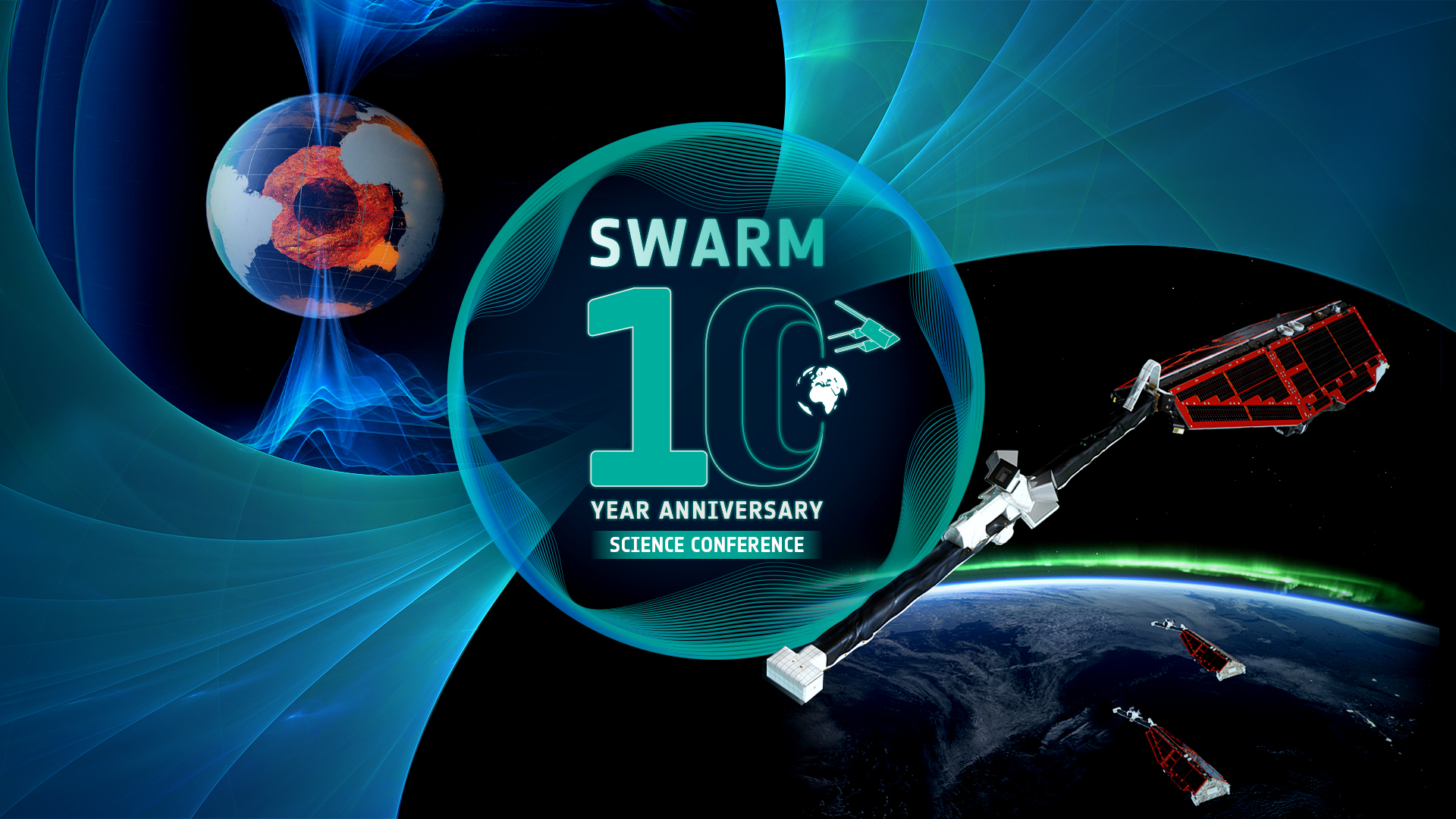
Review of Space Weather
WEEK 1223 from 2024 Jun 03
Solar Active Regions and flares
Solar flaring activity was at moderate levels for most of the week. There was a total of 16 numbered active regions (ARs) observed on the visible solar disk during the week. NOAA AR 3697 (Catania region 28) was the most complex region (magnetic field configuration beta-gamma-delta) and dominated the flaring activity, producing 14 M-class flares. The largest of which was an M9.7 flare from NOAA AR 3697 with peak time 01:49 UTC on June 08. NOAA AR 3709 also produced 3 M-class flares, and NOAA AR 3695 and NOAA 3703 just an isolated M-class flare. The remaining regions on disk were simple and produced C-class flares or were quiet.
Coronal mass ejections
One Halo Coronal Mass Ejection (CME) with a possible Earth directed component was observed during the week. The CME was first observed in the LASCO-C2 coronagraph imagery at 01:48 UTC June 08. The CME was mostly directed west and related to an M9.7 flare with peak time 01:49 UTC June 08, from NOAA AR 3697.
Coronal Holes
A north-south elongated equatorial positive polarity coronal hole crossed the central meridian late June 04.
An east-west elongated negative polarity coronal hole in the southern hemisphere started to cross the central meridian on June 08.
Proton flux levels
The greater than 10 MeV GOES proton flux increased above the 10 pfu threshold on June 08 at 02:55 UTC, and reached a maximum level of 1030 pfu June 08 at 08:00 UTC. The greater than 100 MeV proton flux, as measured by GOES-18, rose above the nominal levels and peaked at 8.3 pfu on June 08 at 03:40 UTC. The proton flux remained above the 10 pfu threshold until late June 09.
This proton event was associated with the M9.7 flare that peaked on June 08 at 01:49 UTC (NOAA AR 3709).
Electron fluxes at GEO
The greater than 2 MeV electron flux remained below the 1000 pfu threshold.
The 24h electron fluence was at nominal levels.
Solar wind
At the start of the week the solar wind conditions were enhanced under the influence of an ICME arrival with the Bz reaching a minimum of -10 nT. After retuning to slow solar wind conditions, they became enhanced again on June 06 possibly due to the arrival of an ICME, with the Bz reaching a minimum of - 15nT, then returned to slow solar wind conditions again by the end of the week.
Solar wind ranged between 252.1 - 549.7 km/s over the week.
Geomagnetism
Geomagnetic conditions were mostly at quiet to unsettled levels, with minor storm level (NOAA Kp 5, Local K Bel 4) on June 03 between 21:00-24:00 UTC and moderate storm level (NOAA Kp 6, Local K Bel 6) on June 07 between 12:00 -18:00 UTC, and active level on June 08 between 00:00-03:00 UTC.
International Sunspot Number by SILSO
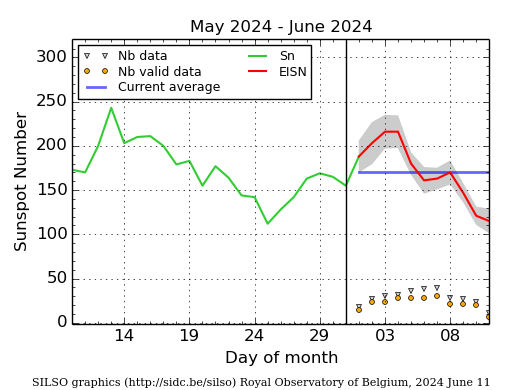
The daily Estimated International Sunspot Number (EISN, red curve with shaded error) derived by a simplified method from real-time data from the worldwide SILSO network. It extends the official Sunspot Number from the full processing of the preceding month (green line), a few days more than one solar rotation. The horizontal blue line shows the current monthly average. The yellow dots give the number of stations that provided valid data. Valid data are used to calculate the EISN. The triangle gives the number of stations providing data. When a triangle and a yellow dot coincide, it means that all the data is used to calculate the EISN of that day.
PROBA2 Observations
Solar Activity
Solar flaring activity was at a moderate level during the week.
In order to view the activity of this week in more detail, we suggest to go to the following website from which all the daily (normal and difference) movies can be accessed: https://proba2.oma.be/ssa
This page also lists the recorded flaring events.
A weekly overview movie (SWAP week 741) can be found here: https://proba2.sidc.be/swap/data/mpg/movies/weekly_movies/weekly_movie_2024_06_03.mp4.
Details about some of this week's events can be found further below.
If any of the linked movies are unavailable they can be found in the P2SC movie repository here: https://proba2.oma.be/swap/data/mpg/movies/.
Saturday June 08
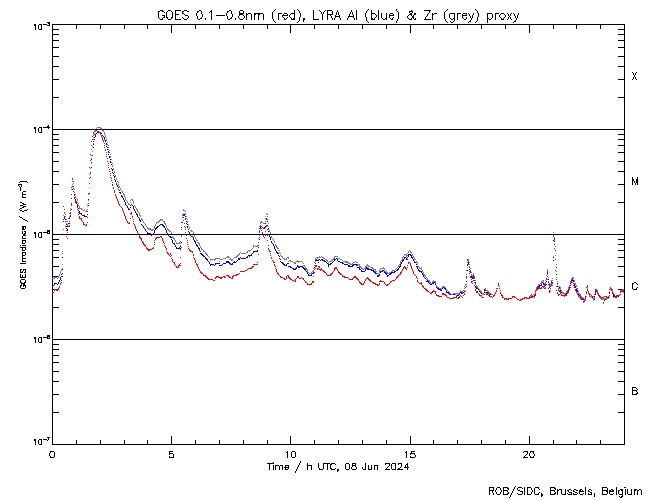
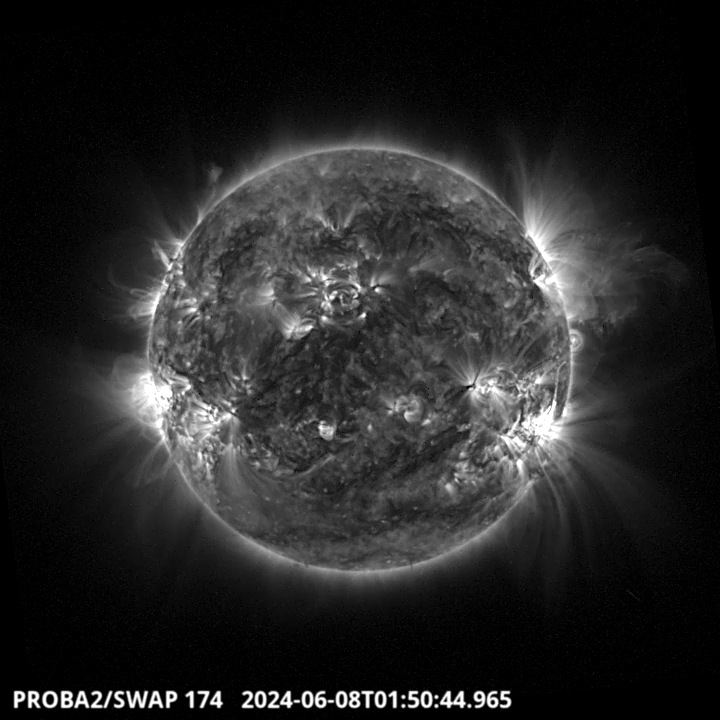
The largest flare of this week was an M9.7, and it was observed by LYRA (top panel) and SWAP (bottom panel). The flare peaked on 2024-Jun-08 at 01:49 UT. It occurred in the south-western quadrant, originating from NOAA AR3697 and it was associated with a large non-radial prominence eruption and a fast halo CME.
Find a SWAP movie of the event here: https://proba2.sidc.be/swap/movies/20240608_swap_movie.mp4.
Noticeable Solar Events
| DAY | BEGIN | MAX | END | LOC | XRAY | OP | 10CM | TYPE | Cat | NOAA |
| 03 | 0459 | 0517 | 0527 | M1.0 | 28 | 3697 | ||||
| 03 | 1149 | 1155 | 1200 | M3.2 | 28 | 3697 | ||||
| 03 | 1218 | 1227 | 1231 | S18W1 | M2.8 | SF | 28 | 3697 | ||
| 03 | 1358 | 1411 | 1423 | N28W42 | M4.8 | 2N | III/2 | 27 | 3695 | |
| 04 | 0609 | 0631 | 0651 | S20W9 | M2.4 | 1N | 28 | 3697 | ||
| 04 | 0857 | 0904 | 0908 | S19W12 | M1.6 | SN | 28 | 3697 | ||
| 05 | 0832 | 0856 | 0914 | S21W25 | M3.4 | 1F | 28 | 3697 | ||
| 05 | 0952 | 1007 | 1017 | S21W25 | M2.6 | 1N | 28 | 3697 | ||
| 06 | 1450 | 1506 | 1522 | S20W41 | M6.1 | 2B | 28 | 3697 | ||
| 07 | 0852 | 0913 | 0930 | S10E84 | M4.0 | SF | III/1 | 3709 | ||
| 07 | 1611 | 1622 | 1642 | S20W50 | M1.2 | SF | 28 | 3697 | ||
| 08 | 0018 | 0028 | 0035 | S13E47 | M1.8 | SF | VI/1 | 46 | 3709 | |
| 08 | 0039 | 0051 | 0057 | S18W53 | M3.3 | 1F | 28 | 3697 | ||
| 08 | 0123 | 0149 | 0219 | S18W53 | M9.7 | 1F | VI/2II/3IV/2 | 28 | 3697 | |
| 08 | 0517 | 0528 | 0538 | S21W61 | M1.5 | SF | III/1 | 28 | 3697 | |
| 08 | 0834 | 0844 | 0854 | M1.2 | /2/3 89/2I/1 | 28 | 3697 | |||
| 08 | 0854 | 0858 | 0902 | M1.2 | /1 | 28 | 3697 | |||
| 08 | 2053 | 2102 | 2107 | M1.0 | II/3 | 38 | 3703 | |||
| 09 | 0649 | 0701 | 0716 | M1.6 | F | 28 | 3697 | |||
| 09 | 0802 | 0819 | 0832 | M1.2 | 46 | 3709 | ||||
| 09 | 1950 | 2017 | 2029 | M1.0 | 28 | 3697 |
| LOC: approximate heliographic location | TYPE: radio burst type |
| XRAY: X-ray flare class | Cat: Catania sunspot group number |
| OP: optical flare class | NOAA: NOAA active region number |
| 10CM: peak 10 cm radio flux |
Geomagnetic Observations in Belgium
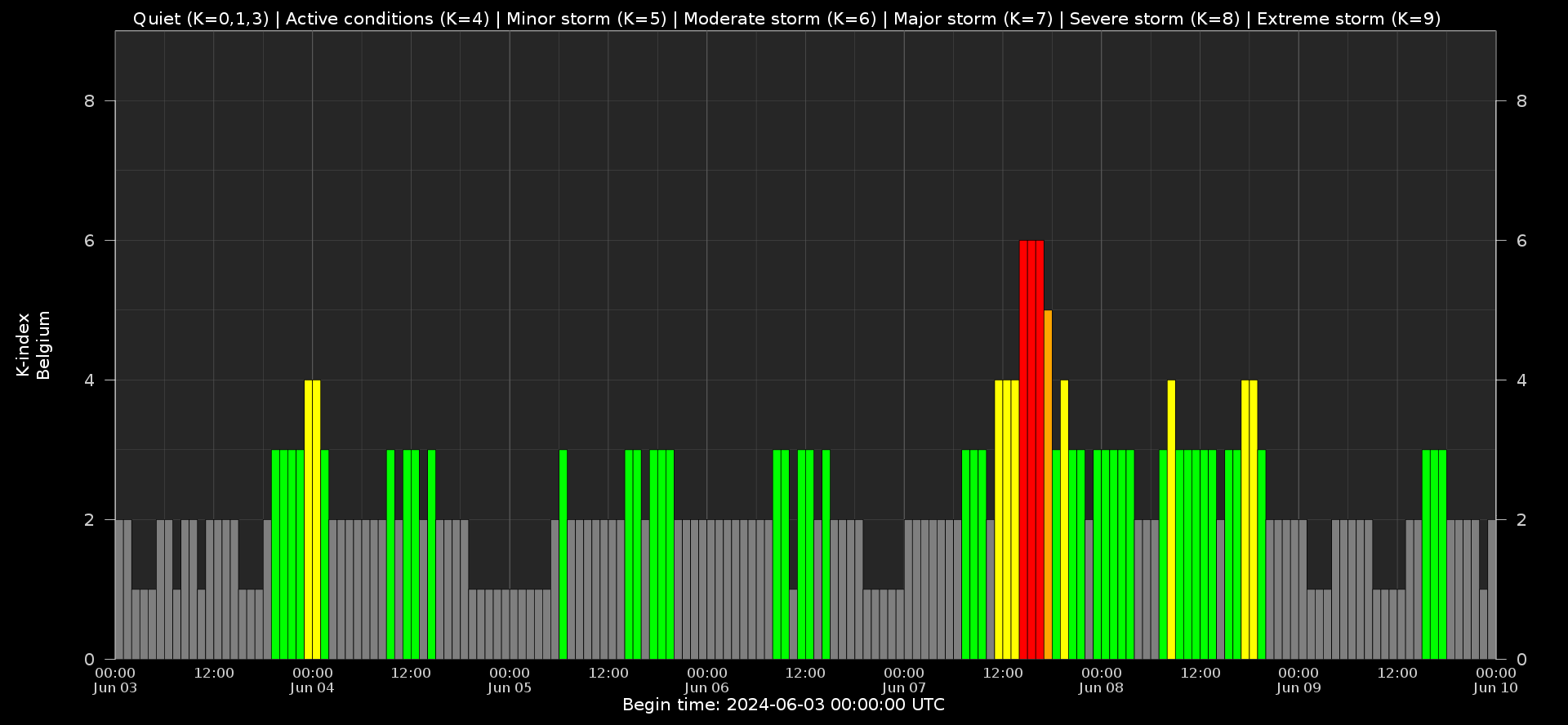
Local K-type magnetic activity index for Belgium based on data from Dourbes (DOU) and Manhay (MAB). Comparing the data from both measurement stations allows to reliably remove outliers from the magnetic data. At the same time the operational service availability is improved: whenever data from one observatory is not available, the single-station index obtained from the other can be used as a fallback system.
Both the two-station index and the single station indices are available here: http://ionosphere.meteo.be/geomagnetism/K_BEL/
Review of Ionospheric Activity
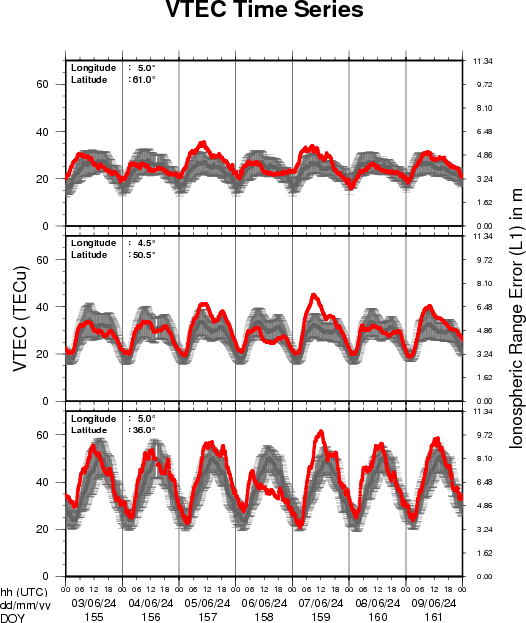
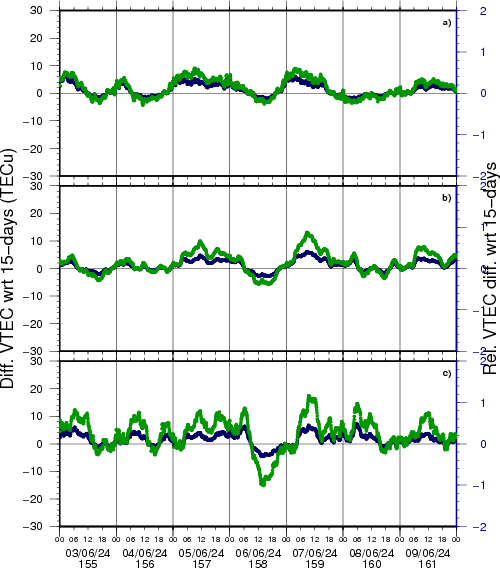
VTEC time series at 3 locations in Europe from 3 Jun 2024 till 9 Jun 2024
The top figure shows the time evolution of the Vertical Total Electron Content (VTEC) (in red) during the last week at three locations:
a) in the northern part of Europe(N 61deg E 5deg)
b) above Brussels(N 50.5deg, E 4.5 deg)
c) in the southern part of Europe(N 36 deg, E 5deg)
This top figure also shows (in grey) the normal ionospheric behaviour expected based on the median VTEC from the 15 previous days.
The time series below shows the VTEC difference (in green) and relative difference (in blue) with respect to the median of the last 15 days in the North, Mid (above Brussels) and South of Europe. It thus illustrates the VTEC deviation from normal quiet behaviour.
The VTEC is expressed in TECu (with TECu=10^16 electrons per square meter) and is directly related to the signal propagation delay due to the ionosphere (in figure: delay on GPS L1 frequency).
The Sun's radiation ionizes the Earth's upper atmosphere, the ionosphere, located from about 60km to 1000km above the Earth's surface.The ionization process in the ionosphere produces ions and free electrons. These electrons perturb the propagation of the GNSS (Global Navigation Satellite System) signals by inducing a so-called ionospheric delay.
See http://stce.be/newsletter/GNSS_final.pdf for some more explanations; for more information, see https://gnss.be/SpaceWeather
The SIDC Space Weather Briefing
The forecaster on duty presented the SIDC briefing that gives an overview of space weather from June 3 to 9.
The pdf of the presentation can be found here: https://www.stce.be/briefings/20240610_SWbriefing.pdf
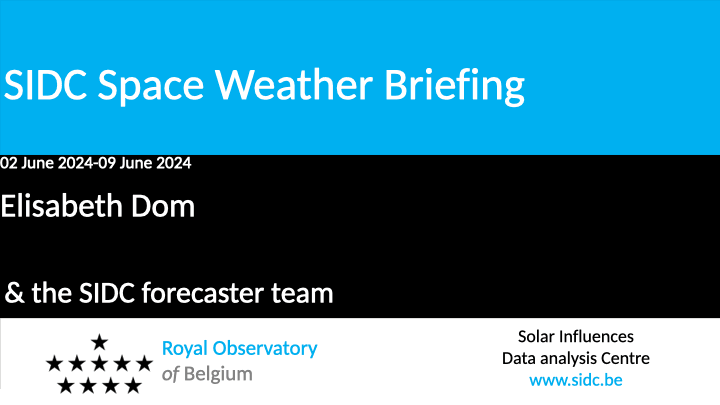
Upcoming Activities
Courses and presentations with the Sun-Space-Earth system and Space Weather as the main theme. We provide occasions to get submerged in our world through educational, informative and instructive activities.
* June 25, Solar physics and Space Weather: predictions and services, online course - Registrations are open
* June 27, STCE annual meeting, Brussels, Belgium
* June 28, public presentation Help! Het stormt in de ruimte!?, Wetenschappelijke middagen, Brussels, Belgium
* July 7, public presentation Totale zonsverduistering op vraag, Proba-3, de eclips-satelliet , Zonnekijkdagen, Genk, Belgium
* Sep 27, STCE at the Wisenight Science festival in the Planetarium, Brussel, https://wisenight.eu/
* Sep 30 - Oct 3, STCE Space Weather Introductory Course, Brussels, Belgium - Registrations are open https://events.spacepole.be/event/204/
* Nov 25 - 27, STCE course: Space Weather impacts on ionospheric wave propagation, focus on GNSS and HF, Brussels, Belgium - Registrations are open, https://events.spacepole.be/event/206/
* Dec 5-6, STCE Course Space Weather impacts on aviation, Brussels, Belgium - Registrations are open, https://events.spacepole.be/event/205/
To register for a course or lecture, check the page of the STCE Space Weather Education Center: https://www.stce.be/SWEC
If you want your event in the STCE newsletter, contact us: stce_coordination at stce.be
